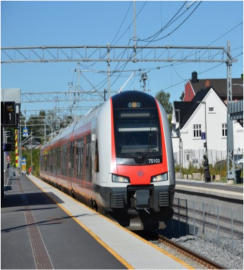
Techniques supporting Resilience for High Integrity Train Control Applications
DESCRIPTION
The objective of the proposed activity is to study GNSS carrier phase integrity techniques for application in railway safety of life applications, and in particular, the evolution of the European Rail Traffic Management System (ERTMS) with virtual balise detection using GNSS.
Carrier phase positioning can achieve a significantly better performance than code-based positioning; however, to date there are no certified integrity concepts applicable to these techniques. Such techniques are expected to provide significantly better accuracies, enabling the use of GNSS in ERTMS operations and scenarios that are not possible today with the performance of existing GNSS code-based integrity concepts.
A significant challenge in the use of carrier phase techniques is bounding of errors and management of discontinuities caused by the railway propagation environment, which is characterised by strong multipath and non-line of sight effects, frequent obscuration and discontinuity of satellite signals and high levels of electromagnetic interference.
Amongst the new “game changing” capabilities foreseen in the evolution of ERTMS, is the realisation of a virtual balise concept using GNSS.
The key industry stakeholders and supporting agencies (European Union Agency for Railways, European GNSS Agency and ESA) have developed a set of coordinated activities to support the roadmap for the realisation of this concept. While this roadmap focuses on the short/medium term with proven solutions to address requirements, there are a number of open problem areas concerning the longer-term evolution that will require innovative solutions.
GNSS carrier phase positioning techniques may offer the required performance if integrity and safety issues can be addressed. Two indicative cases are:
- Positioning for Start of Mission, whereas Precise Point Positioning (PPP) currently lacks certified algorithms providing integrity instead;
- Positioning in Virtual Balise Detection, based on the Relative RAIM (RRAIM) concept which facilitates coasting between safe measurements (measurements stored for the duration in which the reception of integrity alarms from the ground monitor can be guaranteed).
In both the above cases, resilient integrity mechanisms need to consider the railway environment and the prevalence of electromagnetic interference, multipath and non-line of sight conditions. In addition to determining suitable error models, issues such as carrier phase discontinuities and the possibility to repair (possibly using other sensors) should be considered. In the long-term context, use of dual frequency (L1-E1B / L5-E5a) multi-constellation (GPS/Galileo) can be assumed.
The tasks to be performed will include:
- Review of requirements for ERTMS related to start of mission and requirements related to the ERTMS virtual balise concept;
- Review of carrier phase positioning techniques, processing modes, applicability in the railway environment and potential issues for development of a resilient integrity concept;
- Safety analysis for each candidate positioning technique;
- Proposing integrity algorithms for mitigation and bounding residual errors for candidate positioning techniques;
- Experimentation and verification of integrity algorithms using railway measurement data sets.
The results of the activity will, amongst others, provide recommendations for suitability of techniques supporting resilience for high-integrity train control applications, identifying gaps and future work.
The Executive will ensure coordination with on-going GSA activities in the frame of H2020, in particular the STARS project, which is characterising the rail environment via field tests. The activity will also build on available results of the H2020 RHINOS project developed around high-integrity concepts for trains, even if different from the one proposed here, which is based on GNSS carrier phase positioning techniques.
esa-STAR link: http://emits.sso.esa.int/emits/owa/emits.main
